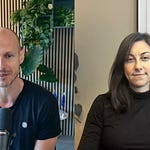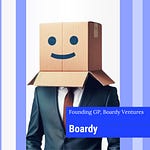European VC Power Law Report: Why Revenue Beats Unicorn Status
Dealroom's recently released 2025 Power Law Investors Ranking 2025 report offers a unique milestone for European venture capital: 700 companies across EMEA now generate over $100 million in annual revenue. These aren't just unicorns floating on paper valuations. These are businesses with real customers paying real money.
The report introduced a new category called "thoroughbreds" to capture this shift toward fundamental business metrics. While unicorns still matter for their forward-looking promise, thoroughbreds tell us something different: which companies actually built sustainable businesses that can weather market cycles.
Today, Andreas Munk Holm digs into this topic and more with Saul Klein, co-founder of Phoenix Court (home to LocalGlobe, Latitude, Solar, and Basecamp) and the #1-ranked investor in the report, alongside Yoram Wijngaarde, founder & CEO of Dealroom.
📊 The Numbers Behind Europe's Growth
Europe now has 700 venture-backed companies generating over $100 million in annual revenue
Revenue provides a more objective measure than valuation for assessing company success
The ecosystem has matured dramatically from finding one $100M+ company every few years to having 700
Europe faces a $35-50 billion funding gap at the growth stage compared to the Bay Area
80% of European scale-up funding comes from overseas investors
After three decades in tech, co-founder Saul Klein sees this as validation of betting early on founders who can build lasting businesses.
Klein reflects on the importance of fundamentals: "Revenue is a much less subjective measure, obviously, than valuation. Valuation is just the consensus between individual investors agreeing on a market price."
The data reveals Europe's maturation. Twenty years ago, finding a venture-backed company with $100 million in revenue happened maybe once every few years. Now we have 700 of them.
Klein puts this in perspective: "20 years ago, we were operating in an ecosystem where companies like Skype, that had reached a hundred million in revenue, were kind of, once every few years. The fact that we now have 700 plus companies doing over a hundred million in revenue."
But Europe faces a serious problem at the growth stage. In 2023, our ecosystem received $35 billion less than the Bay Area alone for rounds of $100 million and above. That gap widened to $50 billion in 2024. Klein explains the challenge: "In 2023, at the scale-up stage, these rounds of $100 million plus, our ecosystem was $35 billion light compared to the Bay Area, not the US, just the Bay Area."
🚦 Why Multi-Stage Matters
Phoenix Court built three vehicles to follow founders across stages: LocalGlobe (seed), Latitude (early growth), Solar (scale-up)
70% of their 54 companies generating over $25M revenue started as seed investments
Following founders through multiple stages provides deeper conviction than purely financial metrics
Wise exemplifies this approach: backed from seed through public markets over multiple funds
Phoenix Court built three vehicles to solve this follow-on problem. LocalGlobe handles pre-seed and seed investments. Latitude focuses on early growth rounds of $15-100 million. Solar backs scale-up rounds above $100 million.
Klein describes their approach using a vivid metaphor: "If you want to meet a great surfer, you live on the beach. You meet her, you want to follow them all the way up into the hills and all the way to the city."
Phoenix Court has 54 portfolio companies generating over $25 million in revenue. 70% of those started as seed investments.
Take Wise, which they backed at seed through LocalGlobe, supported again through Latitude, invested in during its direct listing through Solar, and continues to hold as a public company five years later.
Klein explains their conviction comes from deep relationships: "Someone is investing at an early growth stage or scale-up stage, very few of those firms will have seen the ups and downs. or of those businesses. In our view, numbers only tell you so much, but really, working with the founders, working with their teams, seeing the ups and downs of their evolution gives us a lot of conviction to keep following those, those, those breakouts, founders, and those breakout firms."
🥈 The Discipline of Not Leading
Neither Latitude nor Solar leads investment rounds to avoid conflicts of interest
This structure maintains alignment with founders while preventing price-setting for their own pipeline companies
The approach facilitates LP co-investment opportunities rather than competing with them
Discipline prevents falling in love with every investment in their portfolio
The Phoenix Court differentiator: Neither Latitude nor Solar leads rounds. They concentrate capital on companies they know well and facilitate LP co-investment opportunities. This structure maintains alignment with founders while avoiding the conflict of setting prices for companies that emerged from their own pipeline.
Klein acknowledges the trade-offs: "Occasionally, we will work with a company to write a note to the next round. For me, it's really about supporting founders or teams to kind of build more value into a future financing."
He emphasizes their approach to pricing discipline: "Generally, it's for our perspective, it's kind of maximizing alignment with the founders around not pricing, also being clear to our LPs that we are not going to be setting the prices at the latitude stage for companies that have come out of the LocalGlobe pipeline."
💶 The Seed Advantage
Only 1 in 10 seed investors backs a unicorn, while roughly half of growth-stage investors do
Just 1 in 1,200 seed firms invests in 10 or more unicorns, showing extreme rarity at early stages
Dealroom's methodology awards 100 points for seed vs 30 for Series A based on outcome difficulty
Early-stage success is harder to achieve and sustain than later-stage investing
Critics point out that Dealroom's methodology awards 100 points for seed investments versus 30 for Series A. This appears to favor early-stage investors. Yoram Wijngaarde from Dealroom defends the weighting based on outcome rarity.
He explains the statistics: "About half of growth stage investors invest in a unicorn, and also about half invest in one that reaches thoroughbred status. But only one in 10 seed investors invest in one unicorn. And where it becomes really even more interesting is the ones that invest in 10 or more unicorns. That's one in 1200 firms that invest at the seed stage in 10 plus unicorns."
Klein agrees with this framing about the difficulty of early-stage investing: "To me, early is a mindset, it's not a stage. But you hone that mindset at the seed stage, is my belief. And, in 20, 30 years, I've seen a lot of the series A funds, or even the series B funds, or even the early growth equity funds come down to the beach. The beach is a pretty cool place to be when the weather's nice, but you've got to be crazy to live on the beach 24 seven, 365."
🏇 What This Means for Europe
Top 100 thoroughbreds created over 350,000 jobs in 2024, proving venture capital's economic impact
European pension funds allocate just 2% to venture capital, far below what's needed
Increasing pension fund allocation could close the entire $30 billion funding gap
Most growth capital comes from overseas, meaning value creation benefits foreign economies
The thoroughbreds metric serves two purposes. First, it gives institutional investors concrete evidence of venture capital's impact. Klein highlights the job creation: "I think those top 100 thoroughbreds alone have generated over 350,000 jobs in 2024. So this is not just about science projects. This is about jobs, it's about growth, and it's about economic development."
Klein argues for the need to scale growth capital: "I felt for quite a while now that until we bring in capital at scale at that stage, we aren't really gonna sort of fulfill the potential that we've now, I think, evidenced and demonstrated through these data sets."
Wijngaarde adds another concerning dimension: "Not only is there this 35 to 50 billion gap, but to the extent that European or EMEA scale-ups do get funded, also like 80% is coming from overseas. So even the money that they are raising is barely coming from, is barely local."
🌱 Lessons for Seed Firms
Follow your founders as they grow rather than expanding into new territories
Create institutional vehicles when multiple portfolio companies reach meaningful scale ($25M+ revenue)
Maintain discipline about what rounds to lead versus where to follow
Structure later-stage funds to avoid pricing conflicts with your own pipeline companies
For seed firms considering multi-stage expansion, Klein's advice centers on founder relationships: "My advice would just be to follow your customer, and your customer is the founder. And if your founders keep growing, assuming you are a good partner to your founders, and most seed funds really are, because they've been there at the beginning when nothing exists, you can continue to follow."
Klein describes their evolution: "Every new vehicle that we've created, Latitude and then Solar, has really been a response to wanting to stay in the game and to support the founders."
The progression should feel natural. When multiple portfolio companies hit meaningful scale, creating institutional vehicles makes sense. Klein explains: "When you start to see, at least in our case, there are 54 companies that have hit a $25 million threshold, it makes no sense not to have institutional vehicles, both at the early growth stage and then at the scale-up stage to participate."
🏃♂️ The Long Game
Klein's Netflix investment from 2002 is now worth $1,250 per dollar invested
Amazon stock from 2002 would be worth $20,000 per dollar today
Multi-decade waves (semiconductors from the 70s, internet from the 90s) continue generating returns
Revenue metrics matter more than valuation snapshots for long-term compounding
Companies with real customers can sustain growth through multiple market cycles
Klein offers a compelling perspective on time horizons. He shares his personal experience: "I was lucky enough to compete with Netflix when I was running LoveFilm. And, just to track the Netflix stock, I bought a dollar of Netflix, let's say, in 2002, 2003. I've sat on that dollar of Netflix for 23 years. That dollar is now worth $1,250. If you'd invested your dollar in Amazon in 2002, it would be $20,000 today."
Klein emphasizes the duration of major technology waves: "My observation, having been around for 30 years, is that the biggest waves don't just last for five years or 10 years, they last for decades. To put it in perspective, as an industry, we're still investing in semiconductors, and that wave started in the early 70s. We're still investing in the internet. That wave started in the mid-nineties. We're still investing in mobile and cloud. That wave invested, you know, started in 2008."
This long-term perspective explains why revenue metrics matter more than snapshots of valuation. Companies that build real businesses with paying customers can compound returns for decades. Those that rely primarily on paper valuations often struggle when growth capital becomes scarce.
Europe now has 700 companies proving this model works. The question is whether our capital markets will scale to support the next 700.
⏱️ Here’s what’s covered:
00:39 - Saul on what topping the ranking says about Phoenix Court's approach
01:53 - Yoram explains the thoroughbreds metric
03:49 - Revenue vs valuation debate, lessons from Skype
07:36 - Why Phoenix Court became multi-stage
13:02 - The $35-50 billion growth stage funding gap
17:38 - Advice for seed firms considering multi-stage expansion
22:31 - Defense of the methodology's seed weighting
24:58 - Picking companies at seed vs later stages
Bottom line: Europe has proven it can create substantial venture-backed businesses. The 700 thoroughbreds generating over $100 million in revenue represent a mature ecosystem. But the $50 billion funding gap at growth stage threatens to limit how big these companies can become. Firms that follow founders across multiple stages while maintaining investment discipline will likely capture the best returns as Europe's venture ecosystem continues to mature.
🌍 Takeaways for Founders & VCs
Revenue metrics provide better long-term signals than valuation snapshots for sustainable business building
Multi-stage firms that follow founders from seed through scale-up capture outsized returns by maintaining deep relationships and conviction
Europe's $50 billion growth-stage funding gap creates both a challenge and opportunity for local capital sources to step up
Seed-stage success is exponentially harder than later-stage investing, with only 1 in 1,200 firms backing 10+ unicorns
The best investment opportunities often come from riding multi-decade waves with exceptional founders who can adapt through market cycles
💡 One-liner takeaway
Europe's 700 thoroughbreds prove the ecosystem can build real businesses, but the $50 billion growth-stage funding gap means firms that master the discipline of following founders across decades will compound the winners that drive economic growth.
Before you go…
We also wanted to share the final newsletter from the CO-INVESTIN project, which we’ve been proud to be part of. While the project is wrapping up, the mission continues — connecting Europe’s investment ecosystems, bridging funding gaps, and driving more transparency and inclusion. This edition is packed with updates on new collaborations, upcoming roundtables, insights on diversity and impact investing, and highlights from recent forums shaping the future of European venture.









